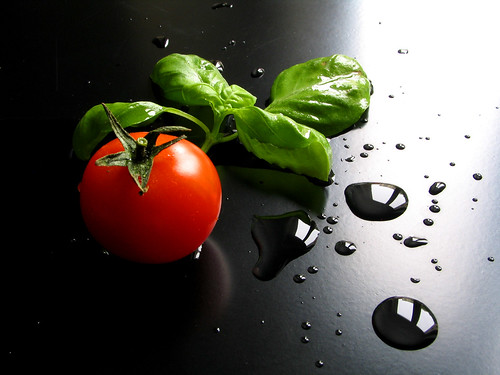Aphrodisiac of the Day: Basil
Is there any herb more refreshing, simple yet intriguing than basil?
Basil (Ocimum basilicum) is a plant native to India that have spread all around Asia and Europe and is one of the most popular herbs in many cuisines - North East Asian cuisine, Thai, Vietnamese, Cambodian in Asia - and in Europe it is most popular in Italian and French cuisine.
Basil is a stimulant and an aphrodisiac. It has such an uplifting, cheerful scent and is used in aromatherapy to combat depression and anxiety (both are probably two of the most potent anti-aphrodisiacs). So if you suffer the winter blues, take advantage of the benefit of this domestic, easy to find, grow and use little herb. You can find it fresh in most supermarkets, and even better – you can get your own plant and keep it by a sunlit window (if you have a kitchen window – all the better).
In herbal medicine, ayurveda and aromatherapy, sweet basil is used for relieving headaches (including migraines), earaches, cold and flu symptoms, sinus congestion, depression, anxiety and fatigue. Its essential oil has antioxidants as well as antiviral and antimicrobial properties. It also aids in digestion and is used to treat various conditions related to the stomach. It also has a balancing effect on the nervous system and is considered an excellent nerve tonic. Sweet basil is said to have the ability to give the mind strength and clarity and as such is regarded as a useful studying-aid to assist in focus, memory and concentration.
There are many types and cultivars of basil. Generally speaking, in warmer countries, Exotic Basil - or the chemotype methyl chavicol is dominant (70-88%), resulting in a spicier, more pungent aroma that is closer to tarragon, fennel or anise in fragrance and flavour, and with the eugenol more dominant as well. In cooler countries, "Sweet Basil" or "French Basil" or else known as the linalol type (with 40-45% linalol) will still have a significant amount of methyl chavicol (over 20%) and will produce a fresher aroma that is more green and light, perceived citrusy by some (due to the limonene and citronellol molecules coming through better). Think about the difference of flavours of basil when you eat it in a Thai curry or in a pho noodle soup; versus in pesto or in Italian dishes.
Other components of basil oil include 1,8-cineole which accounts for its respiratory benefits (this is also present in eucalyptus and rosemary), and eugenol, which gives it spicy, clove-like nuances, methyl cinnamate, which gives it a robust, fruity-spicy character, reminiscent of strawberry and cinnamon in both flavour and scent, and also attracts certain insects. And the limonene (the terpene that characterizes all citrus oils and has a lemon-orange scent) and citronellol (that gives lemongrass, citronella and geranium a fruity-citrusy-rosy personality) we mentioned earlier - which give basil it's uplifting, fresh and light charm reminiscent of citrus.
But back to our topic - there are many customs around basil and love, such as giving basil twigs as token of love in Italy and seal an engagement in Romania; presenting a pot of basil decorated with pompoms to a loved one along with a love poem on Saint John and Saint Anthony Days in Portugal; keeping basil leaves in one's pockets to ensure that their loved one will return their love forever in Mexico. But the most touching legend involving basil is in Decameron and in the poem adapted from it by John Keats titled Isabella and the Pot of Basil.
Basil essential oil happily pairs with jasmine and citrus to create very uplifting, mood enhancing, refreshing scents that act as stimulating aphrodisiac – especially if you like the scent of basil. Burn an ArbitRary candle to bring on this happy mood. Or if you have your own little collection of essential oil, a drop of each basil, lime and jasmine in a diffuser or in the bath will lift your spirit and make you feel sexy and refreshed.
For those of you who prefer basil only in their food – here are two recipe ideas, one savoury and one sweet. That’s right - you can use savoury herbs in desserts to create a surprising, special effect. And there is no better time than now to experiments with such innovative combinations to spice up your life and change an otherwise mundane and familiar flavour into an extraordinary affair!
Savoury Recipe: Polenta with Basil, Tomatoes & Balsamic Reduction
This simple, tried-and-true classic can be assembled in no time, and tomatoes are also an aphrodisiac, due to their bright red and curvy, suggestive shape. I like to this gluten-free alternative to bruchetta as it’s just as delicious and feels much lighter. It will literally 2 minutes to assemble, given that you have all the ingredients on hand.
Ingredients:
1 log of polenta (you can get these in most grocery stores and supermarkets – they look like a big yellow sausage), sliced about ¼” (about 1/2 cm) thick2 Roma tomatoes, sliced
1 bunch basil leaves (I usually get organic ones and don’t wash them at all, as this can take away from the flavour; if not organic – rinse and dry using a salad spinner or gently wipe dry with a towel)
Balsamic reduction
Bocconcini cheese, sliced
Top each polenta slice with a slice of bocconcini cheese. Put a tiny bit of balsamic reduction, top with tomato and garnish with a basil leaf.
I love basil in desserts - especially in the summer in a sorbetto, which can be a wonderful palate cleanser in between courses in a fancy meal. This recipe, however, is for Lime & Basil Macarons. I saw the idea first in Ottolenghi's cookbook and immediately thought it is so brilliant I have to at least bring it up here - even before I try making them myself!


